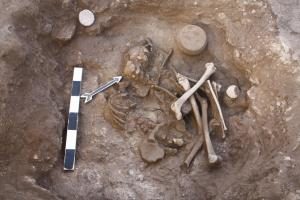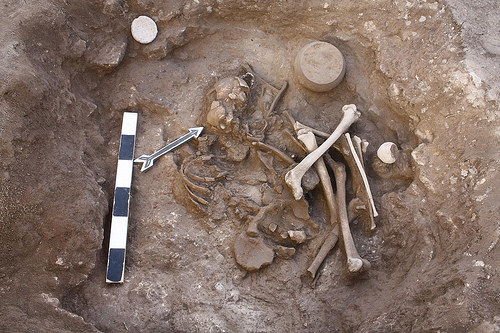
CELL PRESS—The South Caucasus–home to the countries of Georgia, Armenia, and Azerbaijan–geographically links Europe and the Near East. The area has served for millennia as a major crossroads for human migration, with strong archaeological evidence for big cultural shifts over time. And yet, surprisingly, ancient mitochondrial DNA evidence reported in Current Biology on June 29 finds no evidence of any upheaval over the last 8,000 years.
Mitochondria are passed from mothers to their children. Therefore, the study* of mitochondrial genomes enables scientists to trace the unique history of females over time.
“We analyzed many ancient and modern mitochondrial genomes in parts of the South Caucasus and found genetic continuity for at least 8,000 years,” said Ashot Margaryan and Morten E. Allentoft from Centre for GeoGenetics at the Natural History Museum of Denmark. “In other words, we could not detect any changes to the female gene pool over this very long time frame. This is highly interesting because this region has experienced multiple cultural shifts over the same time period, but these changes do not appear to have had a genetic impact–at least not on the female population.”
The researchers were interested to study this part of the world because of its position as a cultural crossroads since ancient times. It’s also known as an important area for the potential origin and spread of Indo-European languages.
To shed light on the maternal genetic history of the region, the researchers analyzed the complete mitochondrial genomes of 52 ancient skeletons from present-day Armenia and Artsakh, an unrecognized republic bordering Armenia and Azerbaijan. Those specimens span 7,800 years of history. Allentoft’s team combined this new data with 206 mitochondrial genomes of modern Armenians and previously published data representing more than 480 individuals from seven neighboring populations.
Their analyses suggest that the population size in the region rapidly increased after the last glacial maximum, about 18,000 years ago. The researchers also used several sophisticated analyses to test five different demographic scenarios that could explain the formation of the modern Armenian gene pool. Despite well-documented cultural shifts in the South Caucasus across the time period in question, their results strongly favor genetic continuity in the maternal gene pool, the researchers report.
The findings imply that the female population in at least some parts of the South Caucasus has been highly stable through many cultural shifts that have occurred over thousands of years. They also suggest that documented migrations into this region during the last 2,000 to 3,000 years have had little genetic impact on the local female population.
Margaryan says the findings suggest either that cultural shifts occurred primarily through the exchange of ideas or that it was primarily men who moved into new territories, bringing new cultural ideas along with them.
The researchers say the next step is to explore these questions in whole-genome data to see if it tells the same story. They also hope to expand the study by including both modern and ancient samples from neighboring countries, which could involve collaborations with researchers in Georgia and Azerbaijan.
_________________________________________________
This photograph shows human remains, excavated in Armenia, that were used for ancient DNA analyses. The remains are of a Middle Bronze Age (17th century BC) individual excavated in Karashamb, burial 462. Credit: Pavel Avetisyan
____________________________________________________
Article Source: Cell Press news release
_________________________________________________
*Current Biology, Margaryan and Derenko et al.: “Eight Millennia of Matrilineal Genetic Continuity in the South Caucasus” http://www.cell.com/current-biology/fulltext/S0960-9822(17)30695-4
_________________________________________________
Receive 30 days free access to the popular new CuriosityStream lineup of documentaries on science, history, nature, and technology as a new Popular Archaeology premium subscriber.
___________________________________________
Travel and learn with Far Horizons.
____________________________________________
This richly illustrated issue includes the following stories: Recent findings shedding new light on the whereabouts of the remains of Philip of Macedon, father of Alexander the Great; how an archaeologist-sculptor is bringing bones of the dead back to life; archaeologists uncovering town life at the dawn of civilization; an exclusive interview with internationally acclaimed archaeologist James M. Adovasio about what makes the Meadowcroft Rockshelter prominent in the ongoing search for the first Americans; what archaeologists are finding at the site of the ancient city of Gath, the home town of the biblical Philistine giant, Goliath; and how scientists are redrawing the picture of human evolution in Europe. Find it on Amazon.com.








